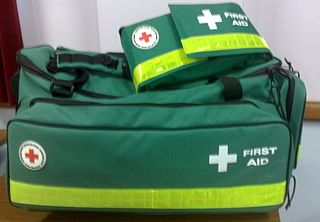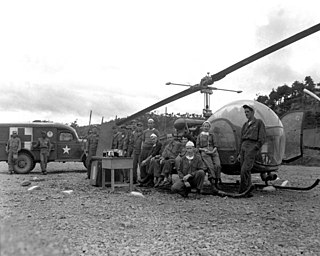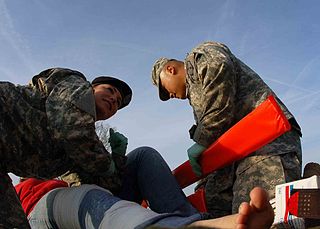Related Research Articles

First aid is the first and immediate assistance given to any person with either a minor or serious illness or injury, with care provided to preserve life, prevent the condition from worsening, or to promote recovery until medical services arrive. First aid is generally performed by someone with basic medical training. Mental health first aid is an extension of the concept of first aid to cover mental health, while psychological first aid is used as early treatment of people who are at risk for developing PTSD. Conflict first aid, focused on preservation and recovery of an individual's social or relationship well-being, is being piloted in Canada.

A first aid kit or medical kit is a collection of supplies and equipment used to give immediate medical treatment, primarily to treat injuries and other mild or moderate medical conditions. There is a wide variation in the contents of first aid kits based on the knowledge and experience of those putting it together, the differing first aid requirements of the area where it may be used, and variations in legislation or regulation in a given area.

Battlefield medicine, also called field surgery and later combat casualty care, is the treatment of wounded combatants and non-combatants in or near an area of combat. Civilian medicine has been greatly advanced by procedures that were first developed to treat the wounds inflicted during combat. With the advent of advanced procedures and medical technology, even polytrauma can be survivable in modern wars. Battlefield medicine is a category of military medicine.

Mobile Army Surgical Hospitals (MASH) were U.S. Army field hospital units conceptualized in 1946 as replacements for the obsolete World War II-era Auxiliary Surgical Group hospital units. MASH units were in operation from the Korean War to the Gulf War before being phased out in the early 2000s. Each MASH unit had 60 beds, as well as surgical, nursing, and other enlisted and officer staff available at all times. MASH units filled a vital role in military medicine by providing support to army units upwards of 10,000 to 20,000 soldiers. These units had a low mortality rate compared to others, as the transportation time to hospitals was shorter, resulting in fewer patients dying within the "Golden Hour", the first hour after an injury is first sustained, which is referred to in trauma as the "most important hour". The U.S. Army deactivated the last MASH unit on February 16, 2006, and the successors to Mobile Army Surgical Hospitals are combat support hospitals.

Internal bleeding is a loss of blood from a blood vessel that collects inside the body, and is not usually visible from the outside. It can be a serious medical emergency but the extent of severity depends on bleeding rate and location of the bleeding. Severe internal bleeding into the chest, abdomen, pelvis, or thighs can cause hemorrhagic shock or death if proper medical treatment is not received quickly. Internal bleeding is a medical emergency and should be treated immediately by medical professionals.

The Expert Field Medical Badge (EFMB) is a United States Army special skills badge first created on June 18, 1965. This badge is the non-combat equivalent of the Combat Medical Badge (CMB) and is awarded to U.S. military personnel and North Atlantic Treaty Organization (NATO) military personnel who successfully complete a set of qualification tests, including both written and performance portions. The EFMB is known for its adherence to its testing standards and, as such, requires strict attention to detail from candidates in order to receive a "GO" on its combat testing lanes. The pass rate for FY 2017 was 7%, making the EFMB one of the most difficult and prestigious Army special skill badges to earn.

An orthopedic cast, or simply cast, is a shell, frequently made from plaster or fiberglass, that encases a limb to stabilize and hold anatomical structures—most often a broken bone, in place until healing is confirmed. It is similar in function to a splint.

Casualty evacuation, also known as CASEVAC or by the callsign Dustoff or colloquially Dust Off, is a military term for the emergency patient evacuation of casualties from a combat zone. Casevac can be done by both ground and air. "DUSTOFF" is the callsign specific to U.S. Army Air Ambulance units. CASEVACs by air today are almost exclusively done by helicopter, a practice begun on a small scale toward the end of World War II; before that, STOL aircraft, such as the Fieseler Fi 156 or Piper J-3 were used.

A shin splint, also known as medial tibial stress syndrome, is pain along the inside edge of the shinbone (tibia) due to inflammation of tissue in the area. Generally this is between the middle of the lower leg and the ankle. The pain may be dull or sharp, and is generally brought on by high-impact exercise that overloads the tibia. It generally resolves during periods of rest. Complications may include stress fractures.

A combat medic is responsible for providing emergency medical treatment at a point of wounding in a combat or training environment, as well as primary care and health protection and evacuation from a point of injury or illness. Additionally, medics may also be responsible for the creation, oversight, and execution of long-term patient care plans in consultation with or in the absence of a readily available doctor or advanced practice provider. Combat medics may be used in hospitals and clinics, where they have the opportunity to work in additional roles, such as operating medical and laboratory equipment and performing and assisting with procedures.
Outdoor emergency care (OEC) was first developed by the National Ski Patrol in the 1980s for certification in first aid, and other pre-hospital care and treatment for possible injuries in non-urban settings. Outdoor emergency care technicians provide care at ski resorts, wilderness settings, white-water excursions, mountain bike events, and in many other outdoor environments.

A tourniquet is a device that is used to apply pressure to a limb or extremity in order to create ischemia or stopping the flow of blood. It may be used in emergencies, in surgery, or in post-operative rehabilitation.
Emergency bleeding control describes actions that control bleeding from a patient who has suffered a traumatic injury or who has a medical condition that has caused bleeding. Many bleeding control techniques are taught as part of first aid throughout the world. Other advanced techniques, such as tourniquets, are taught in advanced first aid courses and are used by health professionals to prevent blood loss by arterial bleeding. To manage bleeding effectively, it is important to be able to readily identify types of wounds and types of bleeding.

Emergency medical responders are people who are specially trained to provide out-of-hospital care in medical emergencies, typically before the arrival of an ambulance. Specifically used, an Emergency Medical Responder is an EMS certification level used to describe a level of EMS provider below that of an emergency medical technician and paramedic. However, the EMR is not intended to replace the roles of such providers and their wide range of specialties.

Combat medics of the United States military may put themselves at greater risk than many other roles on the battlefield. In recent conflicts, the enemies faced by a professional army may not have respect for the laws of war and may actively target combat medics for the significant value they have in keeping the unit combat-effective. Since the non-combatant status granted to medics may not always be respected, modern combat medics carry weapons for personal defense and in most Western armies are virtually indistinguishable from regular infantrymen.

The history of the ambulance begins in ancient times, with the use of carts to transport patients. Ambulances were first used for emergency transport in 1487 by the Spanish forces during the siege of Málaga by the Catholic monarchs against the Emirate of Granada, and civilian variants were put into operation in the 1830s. Advances in technology throughout the 19th and 20th centuries led to the modern self-powered ambulance.
Self Aid Buddy Care (SABC) is a training of the United States Air Force (USAF). SABC encompasses basic life support and limb-saving techniques to help wounded or injured personnel survive in medical emergencies until medical help is available. SABC training is completed every 24 months and is administered to Active Duty, Guard, and Reserve USAF (AF) personnel. USAF changed its SABC administration and training requirements in September 2018: since, active duty has a requirement to complete the training once every three years or when undergoing Personnel Change of Station (PCS).
68W is the Military Occupational Specialty (MOS) for the United States Army's Combat Medic. 68Ws are primarily responsible for providing emergency medical treatment at point of wounding on the battlefield, limited primary care, and health protection and evacuation from a point of injury or illness. 68Ws are certified as Emergency Medical Technicians (EMT) through the National Registry of Emergency Medical Technicians (NREMT). However, 68Ws often have a scope of practice much wider than that of civilian EMTs. This specialty is open to males and females with minimum line scores of 107 GT and 101 ST on the Armed Services Vocational Aptitude Battery (ASVAB).

Tactical Emergency medical services (TEMS) is out-of-hospital care given in hostile situations by specially trained practitioners. Tactical support provided through TEMS can be applied in either the civilian world, generally with special law enforcement teams such as SWAT and SERT, as well as with military special operations teams. Tactical EMS providers are paramedics, nurses, and physicians who are trained to provide life-saving care and, sometimes, transport in situations such as tactical police operations, active shooters, bombings, and natural disasters. Tactical medical providers (TMPs) provide care in high risk situations where there is an increased likelihood for law enforcement, civilian, or suspect casualties. TEMS units are also deployed in situations where traditional EMS or firefighters cannot respond. TMPs are specially trained and authorized to perform live-saving medical procedures in austere and often times unconventional environments. TMPs are also expected to be competent in weapons safety and marksmanship, small unit tactics, waterborne operations, urban search and rescue, and HAZMAT. TMPs also serve to train their respective teams in complex medical procedures that may be performed in their absence. TEMS providers are sometimes sworn police officers cross trained as paramedics, paramedics that are operators trained and integrated into the SWAT Team, or medical providers trained in tactical EMS who are then integrated into law enforcement or military units.

Tactical Combat Casualty Care are the United States military guidelines for trauma life support in prehospital combat medicine, designed to reduce preventable deaths while maintaining operation success. The TCCC guidelines are routinely updated and published by the Committee on Tactical Combat Casualty Care (CoTCCC), which is part of the Defense Committees on Trauma (DCoT) division of the Defense Health Agency (DHA). TCCC was designed in the 1990s for the Special Operations Command medical community. Originally a joint Naval Special Warfare Command and Special Operations Medical Research & Development initiative, CoTCCC developed combat-appropriate and evidence-based trauma care based on injury patterns of previous conflicts. The original TCCC corpus was published in a Military Medicine supplement in 1996. TCCC has since become a Department of Defense (DoD) course, conducted by National Association of Emergency Medical Technicians.
References
- ↑ "FIRST AID:TC 4-02.1" (PDF). armypubs. US Army. Retrieved 2 May 2022.
- ↑ Wang, Xuren; Xia, Demeng; Zhou, Panyu; Gui, Li; Wang, Yixin (2021). "Comparing the performance of tourniquet application between self-aid and buddy-aid: In ordinary and simulated scenarios". American Journal of Translational Research. 13 (6): 6134–6141. PMC 8290695 . PMID 34306352.
- ↑ SLATTERY, LUCILE (July 1960). "Air Force Nurses Progress Toward the Space Age". Military Medicine. 125 (7): 482–488. doi:10.1093/milmed/125.7.482. PMID 13831631.
- ↑ Daneshmandi; Asgari; Tadrisi; Ebadi; Mokhtari (2011). "Effect of self-aid and buddy-aid education by lecture and multimedia software package methods on the knowledge level of military cadre" (PDF). Journal of Military Medicine. 13 (1): 7. Retrieved 2 May 2022.